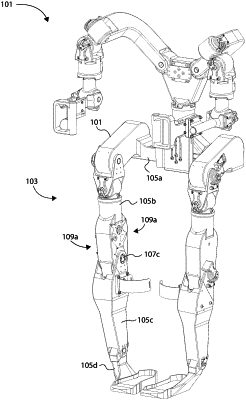| CPC B25J 9/0006 (2013.01) [A61F 2/64 (2013.01); A61F 2/68 (2013.01); A61F 2/70 (2013.01); B25J 9/148 (2013.01); B25J 13/085 (2013.01); A61F 2002/5003 (2013.01); A61F 2002/5072 (2013.01); B25J 19/007 (2013.01); F15B 11/072 (2013.01); F15B 15/12 (2013.01); F15B 15/204 (2013.01); F15B 2211/3058 (2013.01); F15B 2211/7058 (2013.01)] | 22 Claims |

|
1. A robotic system for a robotic limb configured to recover energy for minimizing power consumption of the robotic system, comprising:
a first support member;
a second support member; and
a quasi-passive elastic actuator rotatably coupling the first and second support members to define a joint of the robotic system rotatable about an axis of rotation defining a degree of freedom, the quasi-passive elastic actuator comprising:
a housing coupled to the first support member;
a first vane device supported by the housing and coupled to the second support member;
a second vane device coupled to the housing and interfaced with the first vane device, the first vane device and second vane device being rotatable relative to each other within the housing and defining, at least in part, a compression chamber and an expansion chamber;
a valve assembly located and operable at the joint of the robotic system, the valve assembly comprising a valve device disposed through an opening of the first vane device along the axis of rotation; and
a shunt circuit facilitating fluid flow between the compression and expansion chambers through the valve assembly,
wherein the valve assembly is operable to position the valve device in an open position to open the shunt circuit to permit fluid flow between the compression and expansion chambers, thereby placing the quasi-passive elastic actuator in an inelastic state, and
wherein the valve assembly is operable to position the valve device in a closed position to close the shunt circuit to restrict fluid flow between the compression and expansion chambers, thereby placing the quasi-passive elastic actuator in an elastic state, the quasi-passive elastic actuator being operable in the elastic state to store and release energy and to apply an augmented torque to rotate the first support member relative to the second support member.
|